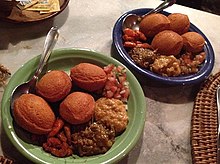Akara is a dish made from peeled beans formed into a ball and then deep-fried in dendê (palm oil). It is found in West African and Brazilian cuisines. The dish is traditionally encountered in Brazil’s northeastern state of Bahia, especially in the city of Salvador.
Acarajé serves as both a religious offering to the gods in the Candombléreligion and as street food. The dish was brought by slaves from West Africa, and can be found in various forms in Nigeria, Ghana, Togo, Benin, Mali, Gambia and Sierra Leone.
Acarajé is made with cooked and mashed black eyed peas seasoned with salt and chopped onions molded into the shape of a large scone and deep-fried in palm oil in a wok-like pan in front of the customers.It is served split in half and stuffed with vatapá and caruru– spicy pastes made from shrimp, ground cashews, palm oil and other ingredients. A vegetarian version is typically served with hot peppers and green tomatoes. Acarajé can also come in a second form called abara, where the ingredients are boiled instead of deep fried.
Akara (as it is known in southwest and southeast Nigeria) a recipe taken to Brazil by the slaves from the West African coast. It is called “akara” by the Yoruba people of south-western Nigeria and by the citizens of Sierra Leone, “kosai” by the Hausa people of Nigeria or “koose” in Ghana and is a popular breakfast dish, eaten with millet or corn pudding. In Nigeria, Akara is commonly eaten with bread, Ogi (or Eko), a type of Cornmeal made with fine corn flour.
Akara plays a significant role in the Yoruba culture, as it was specially prepared when a person who has come of Age (70 and Above) dies. It was usually fried in large quantity and distributed across every household close to the deceased. Akara also used to be prepared in large as a sign of victory, when warriors came back victorious from war. The women, especially the wives of the Warriors were to fry Akara and distribute it to the villagers.
In Sierra Leone, Akara is composed of rice flour, mashed banana, baking powder, and sugar. After mixed together, it is dropped in oil by hand, and fried, similar to Puff Puff. It then forms into a ball. It is usually prepared for events like Pulnado (event held due to the birth of a child), a wedding, funeral, or party. No matter how big the occasion, this item is a classic in the Sierra Leonean community.
Acarajé sold on the street in Brazil are variously made with fried beef, mutton, dried shrimp, pigweed, fufu osun sauce, and coconut.Today in Bahia, Brazil, most street vendors who serve acarajé are women, easily recognizable by their all-white cotton dresses and headscarves and caps. The first appeared in Bahia selling acarajé in the 19th century. The city now has more than 500 acarajé vendors. The image of these women, often simply called baianas, frequently appears in artwork from the region of Bahia.Acarajé, however, is available outside of the state of Bahia as well, including the streets of its neighbor state Sergipe, and the markets of Rio de Janeiro.
Ingredients
- 1 cup peeled beans
- 1 raw hot pepper (Ata rodo) – chopped
- Salt – to taste
- 1/2 teaspoon baking soda (optional. This helps to make the exterior crunchy)
- 1/2 of a medium onion – chopped
- oil for frying
Directions
- Combine the beans with 1/4 cup water in a blender.
- Puree the mixture to a smooth paste
- Pour the pureed beans into a bowl. Mix for 5 minutes with a whisk or mixer. This is to incorporate air into the batter.
- Set a deep pan on medium heat, add in some oil. Heat until oil
- Add in the salt, baking soda, chopped pepper and onions. Stir
- Scoop 1/2 cooking spoon of batter into oil. You do not want to spread out the batter in the oil, you want to pour batter directly on itself (the way you would pour water into a narrow bottle).
- Fry on each side until golden brown .
- Lift the akara balls out with a slotted spoon and drain on kitchen paper towels.
- Repeat the process until everything is fried
- Serve with bread, garri, ogi(pap) or fried yam. Enjoy!!
Note: The shape of the akara is affected by two factors: thickness of the pureed beans and your method of frying. Shallow frying or watery batter will result in flat akara.




